How Does the Rook Move in Chess? (Complete Guide)
Do you still need to learn how does the rook move in chess? Including the notorious castle move, this overview shows you every possible move this ‘tower’ Piece can make.
There is no limit to how many squares the rook can move vertically or horizontally in a straight line. The king is the only piece that can move past a rook of the same color during castling. It captures as soon as the rook occupies an enemy piece’s square.
As a result of their simple movement rules, rook movement is relatively easy to understand. During the switch from king to castle, the rook has different behavior. There are very few complex movements involved in the basic movements.
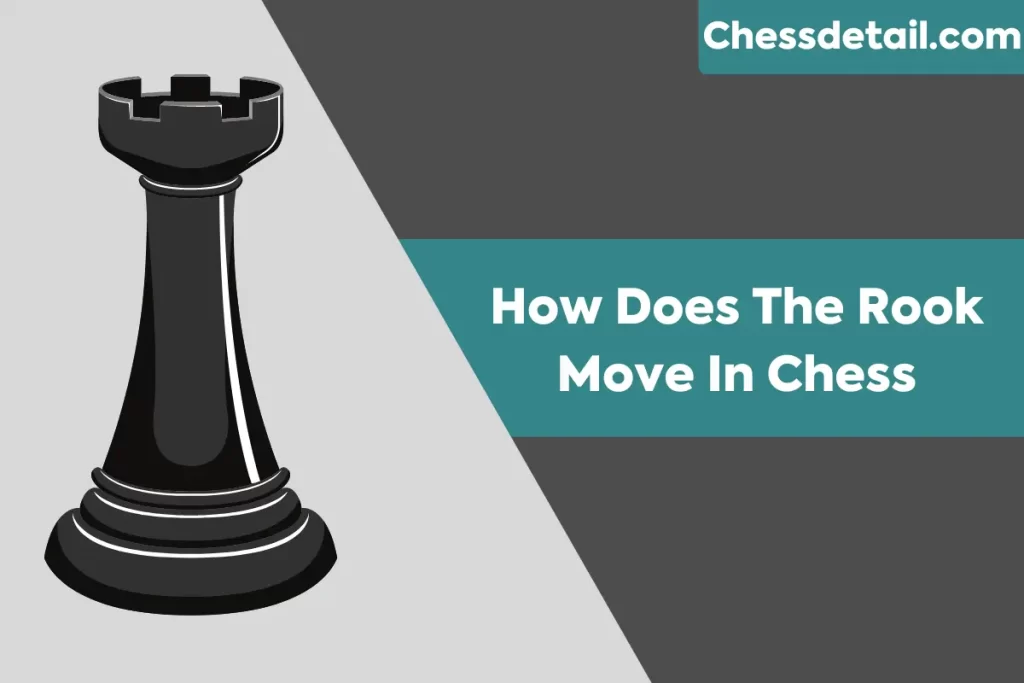
What Is a Rook in Chess?
A rook was often symbolized by a chariot in earlier forms of chess, though it is most commonly represented as a tower or castle in modern sets. Modern names are derived from Persian words such as rukh, which means chariot.
Rooks are regarded as major pieces in terms of relative value. Compared to bishops and knights (both minor pieces), pawns are two more valuable than two bishops or two knights. The strength of a pair of rooks (by one pawn) is slightly greater than a pair of queens (by one pawn). There are a few non-king pieces in the game that are more valuable than it after the queen.
A Rook Moves Horizontally And Vertically
There are only a few basic movements a rook can make. There are four directions that rooks can move in a straight line: up, down, left, and right. Providing other pieces do not move past (or “jump over”) the rook, it can move for as many unoccupied squares as possible. Here is a diagram to visualize rook movement:

In straight lines, the rook goes up, down, left, right, and in any direction
The player generally moves Rooks according to how many squares they move. A special exception is when it can move past a piece of the same color. A rook can only ‘jump’ over another chess piece once during the special chess move called casting.
How does the rook move in castling?
In chess, casting is one of the most important moves. The only move in chess that allows both pieces to move simultaneously is the double move. King sides move two squares (queenside castling) or right (kingside casting) while rooks move alongside the king.
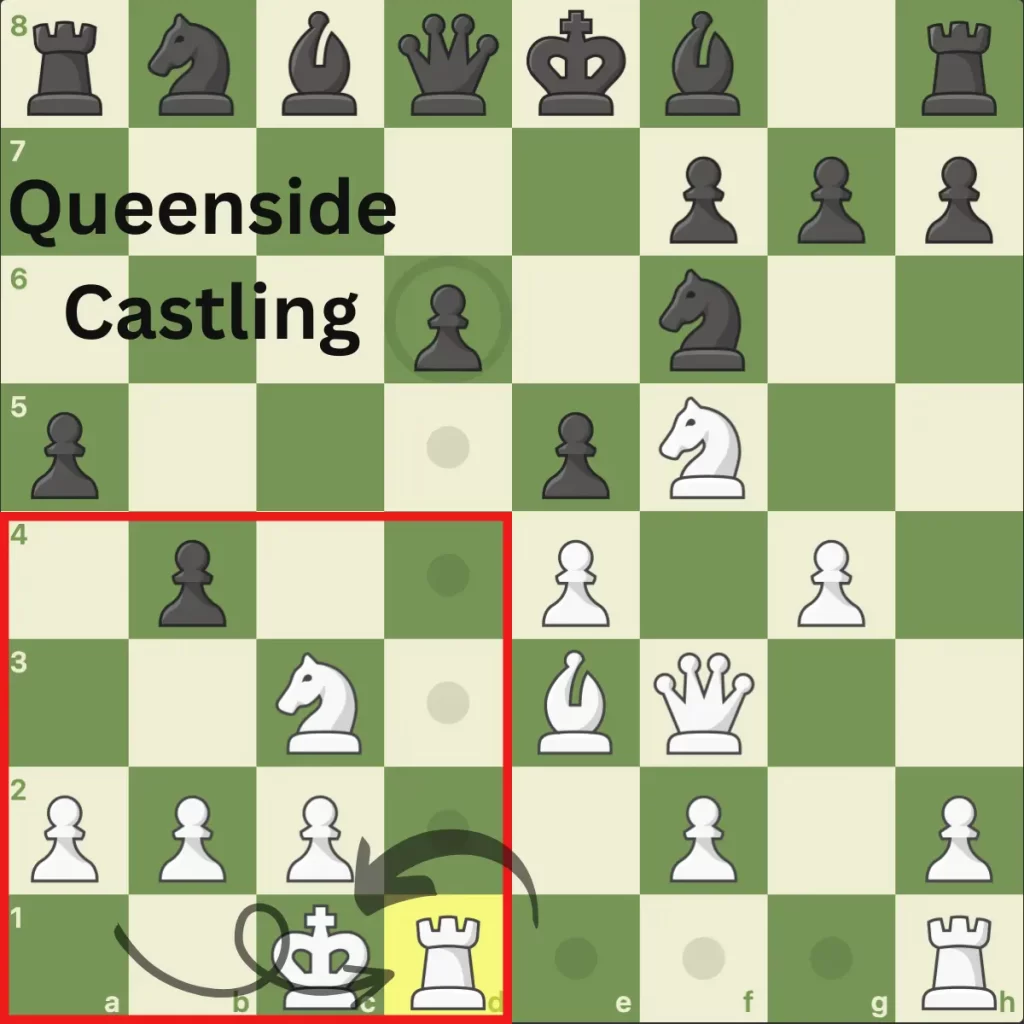
Unlike other types of castling, the rook moves close to the king when this type of castling is used.
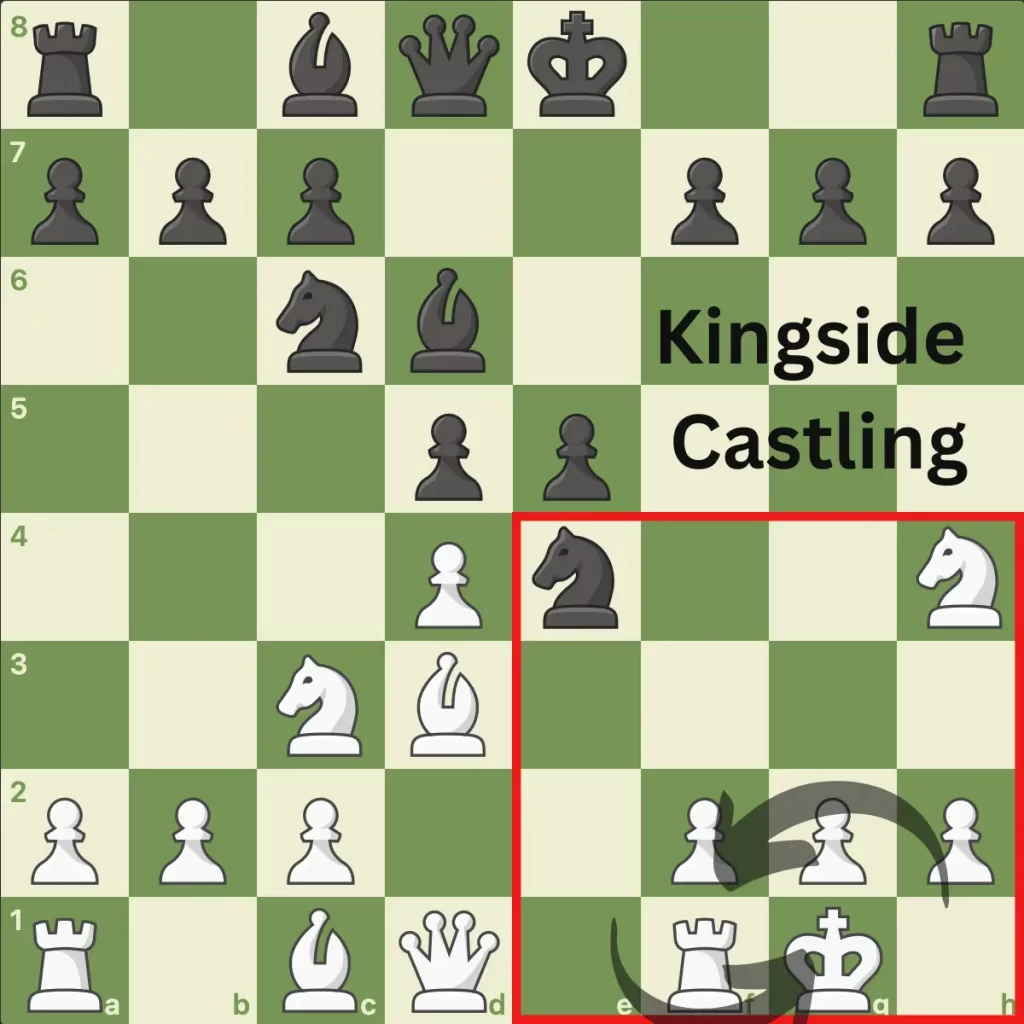
From its starting position, the king moves to the right two squares, and the rook moves beside it.
How A Rook Moves When Attacking
As with other pieces in chess, the rook can be used to attack an opponent’s piece. Attacking rooks move onto the squares of their opponent’s pieces and take them. Once the taken piece has been placed, the rook is placed there as well.
In the diagram below, we can see how a rook attacks (horizontally or vertically in a straight line):

Attacking and moving onto the attacked square is the rook’s move
When a rook is defending a piece (protected by another piece), it can attack that piece as well. Trading occurs when you attack a defended piece from an opponent and lose the rook. Keep these chess pieces in mind when making a favorable trade:
- King: infinite points
- Queen: 9 points
- Rook: 5 points
- Knight: 3 points
- Bishop: 3 points
- Pawn: 1 point
The rook is one of the most valuable chess pieces, so you should consider trading it only for the queen or rook of an opponent. It may be possible (for example, to force a checkmate later) to take a knight, bishop, or pawn in very rare situations. Here is an example of a rook trading with a strategic advantage:

Using rooks to attack a queen on defense is an example of a favorable trade.
Rook Castling Chess Move
You can only move one piece at a time in chess, which is one of the most basic rules. The rule applies in all situations, except when casting is used. In chess, this exceptional move provides protection for your king as well as development for one of your rooks. There will also likely be some time during the game when the enemy king will try to castle.
Basically, castling allows you to move your king two spaces to either side of your board while moving your rook two spaces to its left or right. The rook and the king must not have moved from their starting positions, and there must be a number of unoccupied squares between them.
Castling is defined in this way by FIDE, the international chess organization. As a single move of the king, this involves moving the king and either rook along the first rank. When the king transfers, the rook is moved to the square where the king has crossed two squares, and the king crosses two squares.
Rooks on the Seventh Rank
It is usually a pleasure for rooks to trade pawns and pieces. As the position opens up, the rook becomes stronger. A rook prefers the seventh rank as its preferred location. From your own side, that is the seventh row. Black rooks are ranked 2 for this position. Having a rook on the seventh rank allows you to do the following:
- By attacking from the side, unmoved pawns can be defeated.
- The back row is the best place to trap the king.
There are times when it is worthwhile to sack a pawn in order to gain a rook on rank 7. White played the powerful 1.Rd7 in this position, giving black a pawn up!
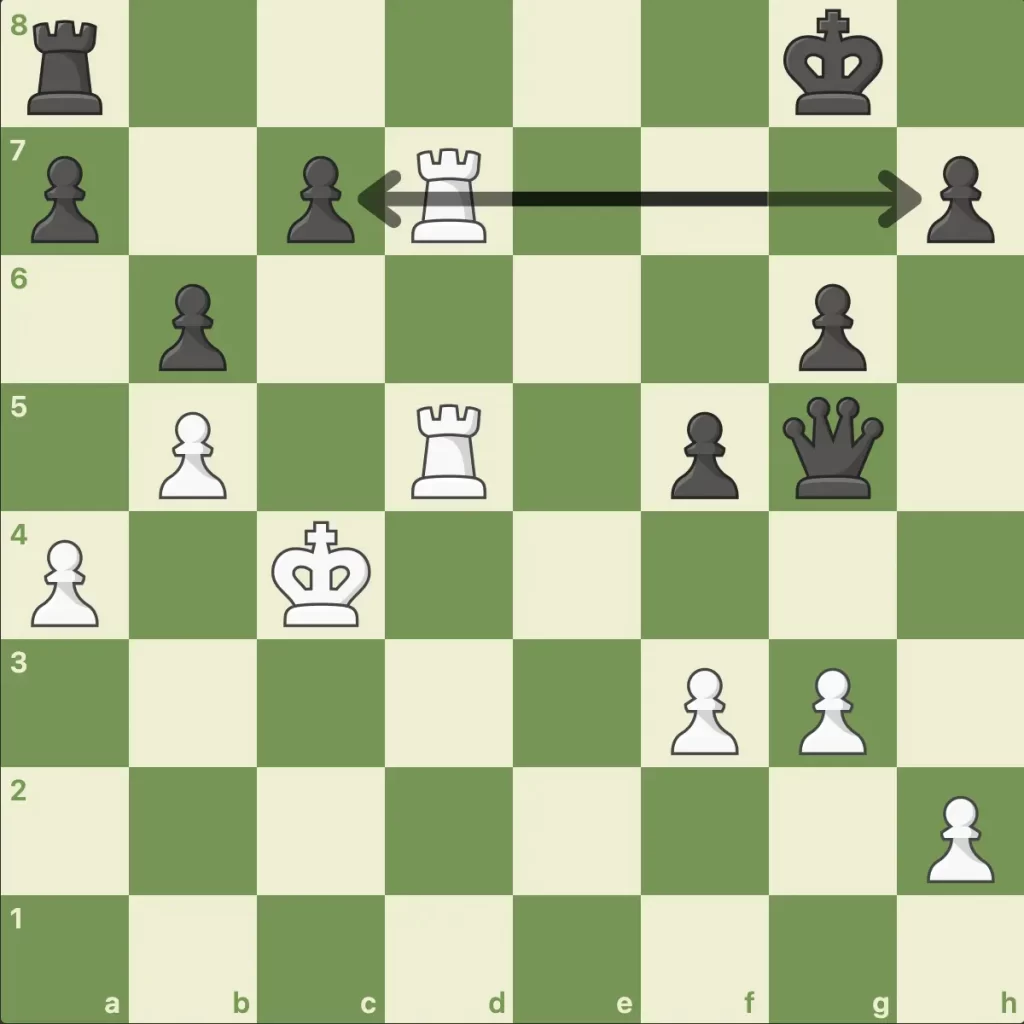
Black king is cut off by the white rook on the last rank. As a result, the king is unable to play. As well as c7 and h7, the black pawns are attacked at both positions. In the absence of an alternate path, pawns cannot defend themselves effectively from one side. The pieces will have to be protected by Black. The white team has the advantage in this game.
The rook must be used to defend the pawn on c7. I would recommend playing 1…c5. However, white may be able to capture it by means of en passant (2.bxc6 e.p.).
1…Rc8 2.Kd5
White plans to win pawns while the black pieces are trapped on guard duty. A good counter to this plan does not exist for black.
Black’s pawn endgame is losing because the white king is better placed, after 2…h6 3.Kc6 Kf8 4.Rxc7 Rxc7+ 5.Kxc7 1-0. (5…Ke7 6.Kb7 Kd6 7.Kxa7.)
When both rooks reach the seventh rank, they have the most fun! As a starting point, let’s examine how checkmate can be achieved in the seventh rank with double rooks.
Scenario 1: Black’s typical mate in three is shown in this diagram:
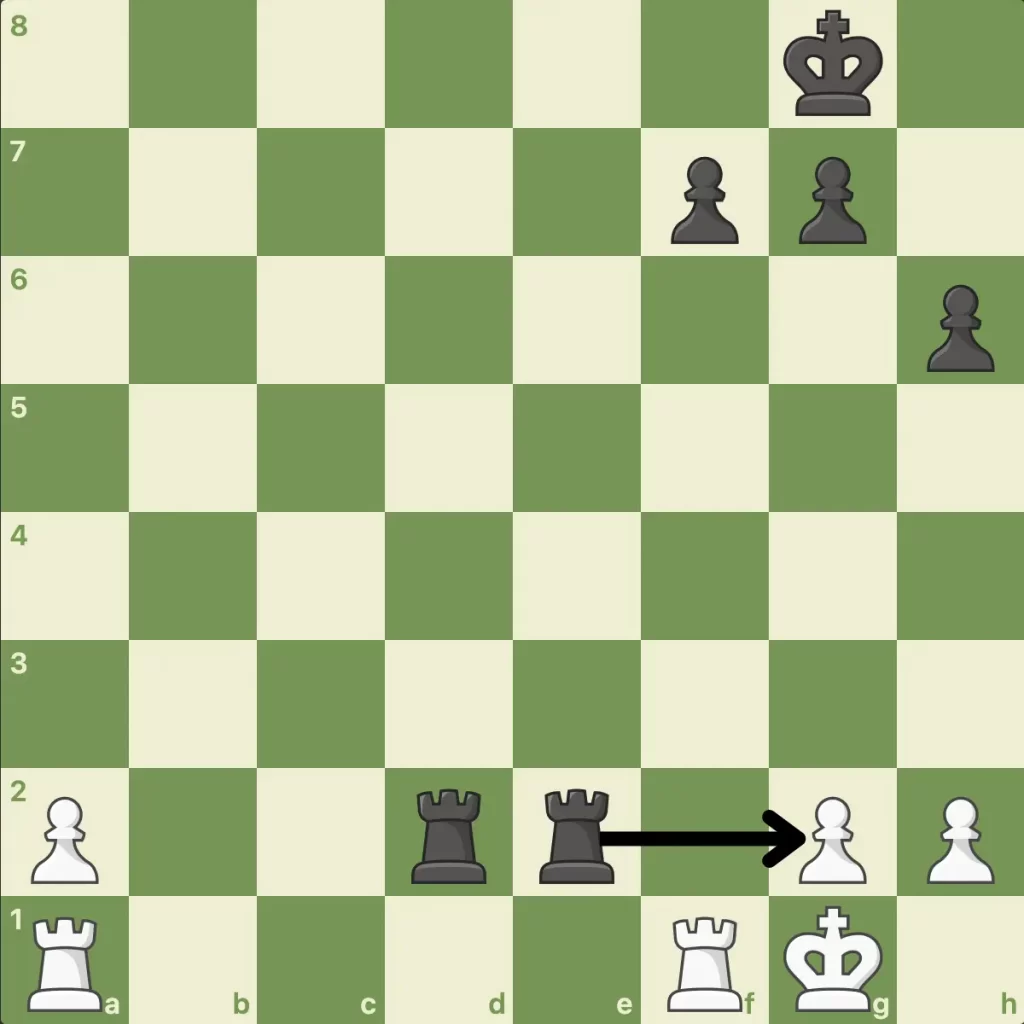
1…Rxg2+ 2.Kh1 Rxh2+ 3.Kg1 Rdg2#
Scenario 2: White has mate in two when playing black
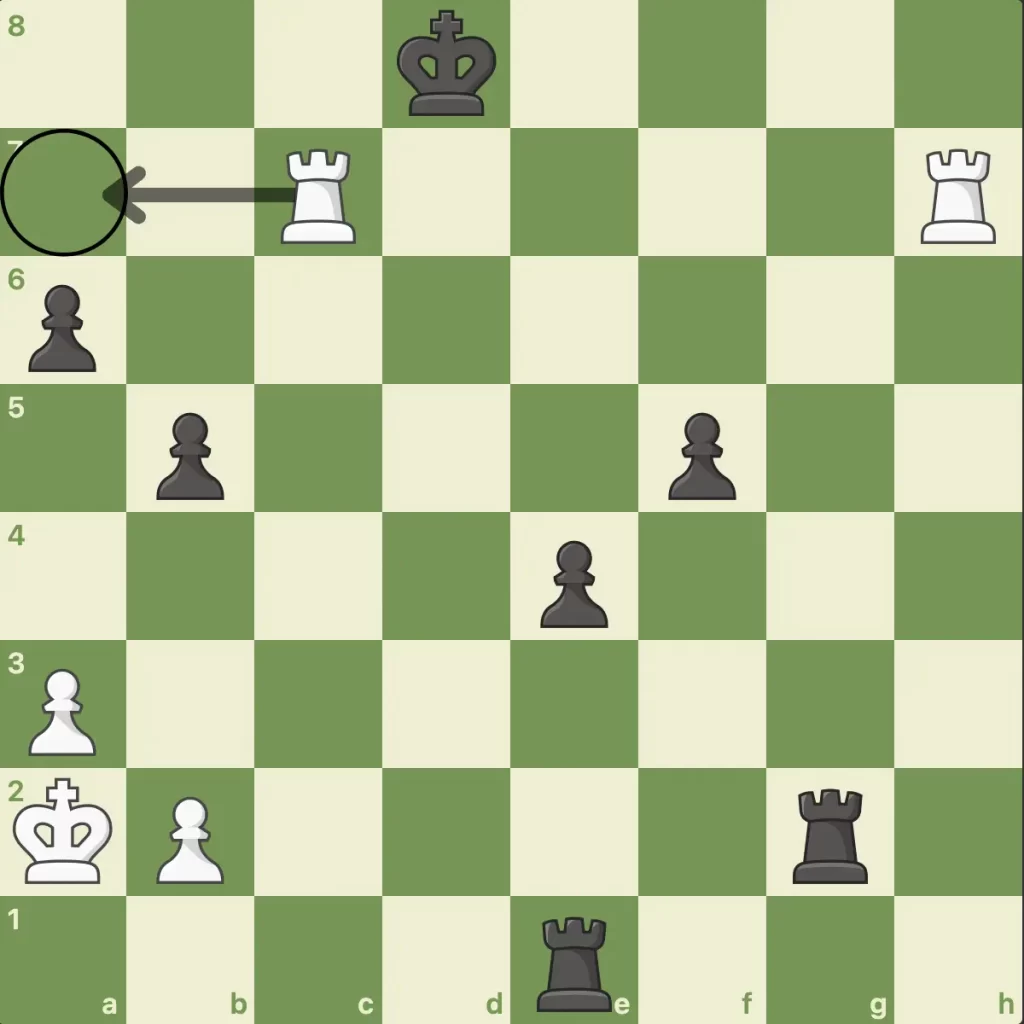
1.Ra7! 0-1
The doubled rooks are also capable of saving you from defeat as well as winning you games. In general, perpetual checks are used to draw. By checking for dear life, white may be able to escape with a draw. 3.Rxh7+ Kg8 2.Rg7+ Kh8 3.Rxh7+! Whenever the rook on e7 is checked, the check is lost. 3. Rxh3+? Qc6+! 4.Kg2 Qc5+? The checks are over after the black king reaches d8, not ( 3.Rxh3+? Qc6+!)
3…Kh8 4.Rh7+ Kg8 5.Rh7+ ½–½
Can a rook capture the king?
Chess kings cannot be captured by rooks because rooks cannot capture them. Checking or checkmate, however, can be achieved by the rook. The end of a chess game is the checkmate, which comes just before the king is captured. It is important to understand the term “checkmate” very clearly before you can understand this point.
The next move of the opponent may result in a checkmate of the king. Checkmating refers to your opponent attacking your king. Unless you capture the opponent on his next move, there is no way out.
A game of chess ends immediately after this point of checkmate, according to standard chess rules. See my article about whether a king can take a king in chess to learn more. Sometimes, online games do not allow you to capture the queen with your rook if you play online. Let’s talk about it!
Can a rook capture a Queen?
It is possible for rooks to capture queens. Rooks cannot capture any pieces in this scenario until the king is taken out of check.
According to standard practice,
Taking the king out of check before making any other move is necessary if the king is in check.
The reason why you cannot take a piece from your opponent with your rook in an online chess game is only for this reason. The first thing you have to do in chess is take your king out of check whenever it falls into check. The following three methods can be used to accomplish that:
- A check is captured by capturing the piece that provides it
- Ensuring the safety of the king
- Maintaining a piece of paper between the check and the bank
Consider the case where your king is being checked by a queen or another chess piece. Rooks can capture those pieces. Once that piece is captured, you can use your rook to capture it. An attacker’s king can also be saved by taking the check-giving piece, isn’t it? Hopefully, you now understand what I mean.
Rook Strategies and Techniques
It can be difficult to develop rooks effectively due to the fact that they are among the most powerful pieces on the board. The rook may be hemmed in for much of the opening because it cannot move diagonally or skip over pieces. It is unlikely that enemy pawns can stop your rook, but there are ways to limit its mobility. A number of openings depend on rook development.
In addition to connecting your rooks, casting also allows you to get them talking. Rooks that communicate or chat (also known as connecting) have an open rank between them. As a result, they can patrol the rank freely, supporting other pieces while protecting them against enemies.
Endgames are known to be a great place for rooks. Rooks, rooks, and pawns play an important role in many foundational chess endgames. Before checkmate can be achieved, these situations can require dozens of moves. Learn about endgame tactics by reading a few manuals and analyzing their problems and positions. By memorizing the Philidor Defense and Lucena Positions, you’ll at least get a sense of the complexities involved in rook endings.
Faqs
Rooks are often the subject of very specific questions for beginners. No question is too strange when it comes to an understanding of the role a rook plays in chess. Those two beautiful towers can be moved around the board in a few different ways, so here are some questions people ask.
Question 1: Does the rook have a special move?
Answer: When an enemy piece is captured, it is removed from the game by moving to its square. In a special move called castling, the rook participates with the king as well by transferring to the square crossed by the king.
Question 2: Can a rook capture a pawn?
Answer: To reach the end of the board, the rook cannot jump over the knight. Before being blocked by the black pawn, it can only move one square up. Pieces can capture pawns when they play two squares up and cross over them since pawns are opposing pieces (different colors).
Question 3: Can A Rook Move Backwards?
Answer: Rooks can move straight backward in chess if they are in a vertical line. To move vertically, a rook must pass through an unoccupied square. Backward diagonal movement is not allowed for rooks. A turn around a corner cannot be taken in one turn. You cannot move a rook over or around another piece. Only the castle move is an exception.
Question 4: Why is a rook stronger than a bishop?
Answer: In chess, a rook is more valuable than a bishop since it can reach all the squares instead of just half of them. The rook and king can reach checkmate, but the king and bishop cannot. Because a rook covers more squares than a bishop, it is worth more in general.
Question 5: Can A Rook Move Twice?
Answer: Chess rules prevent rooks from moving twice in one turn. At the beginning of a new turn, a rook may move again. Despite its limited mobility, a rook is the only chess piece that could be moved as the second chess piece (following the king) during a single turn. Chess doesn’t allow a rook to move twice during every other regular turn. If you play the game, remember this.
Question 6: Why can’t I move my Rook to the starting position?
Answer: Chess beginning positions have pawns blocking the Rook, which is unable to jump over them nor move unless the flanking wing pawns are freed. Castling usually triggers the Rooks’ activity.
Conclusion
The moves and captures of the rook in chess are something you’ve already mastered, correct? It would be appreciated if you shared this article with others if you found it helpful. That’s all I have to say! Enjoy your day, and thanks for your help!
If you want to learn more about chess, then don’t forget to read different articles like Chess Tournament Rules and Can you Castle out of Check.


![How Does the Bishop Move in Chess [Everything Explained]](https://chessdetail.com/wp-content/uploads/2023/05/How-does-the-Bishop-move-in-chess-768x512.webp)

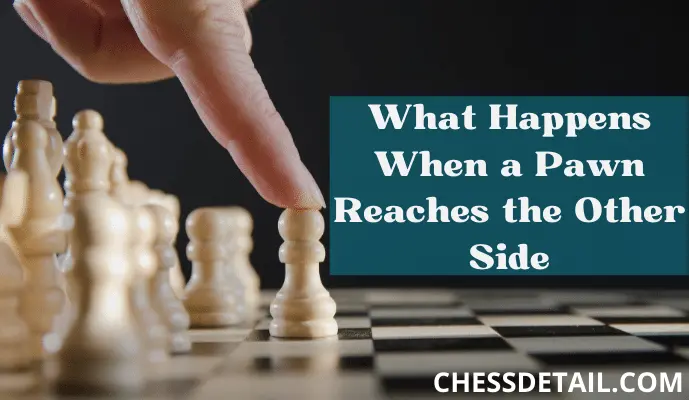

![Chess Piece that Moves Diagonally [Explained all 4 Pieces]](https://chessdetail.com/wp-content/uploads/2022/06/Chess-Piece-that-Moves-Diagonally.webp)